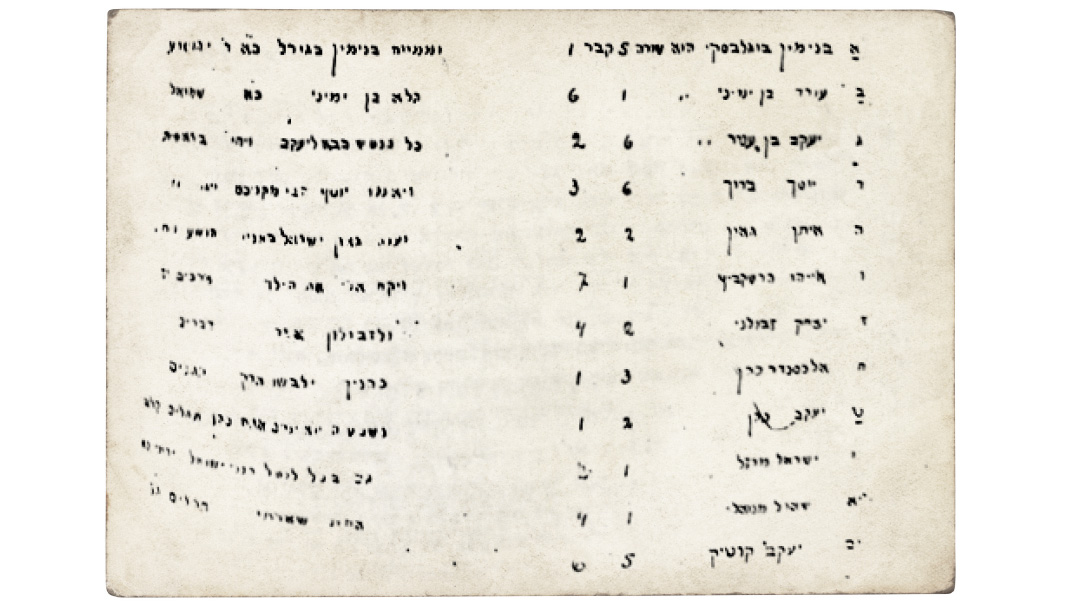Naming the Unknown Soldiers
| January 17, 2023And so the goral continued, clearly indicating each and every unknown fighter

Just south of Ramat Beit Shemesh lies Kibbutz Netiv HaLamed-Hei. An imposing memorial at the kibbutz entrance sheds light on the origin of its name.
It was in this area that the ill-fated Convoy of 35 traversed the plain, bringing desperately needed medical care and weapons to the beleaguered defenders of Gush Etzion on the night of January 15-16, 1948. The 35 fighters from the Palmach and other groups navigated the rough terrain on foot, trying to reach the outermost settlements by daybreak. Due to the 26-kilometer hike, starting out behind schedule, and being overloaded with gear, they were still in the open at sunrise. When they were spotted by local Arab fighters, a gun battle ensued, and by 4:30 p.m., all 35 had been killed.
The British police chief of Chevron, Hamish Dougan, arrived at the scene and arranged for evacuation and temporary burial of the bodies in nearby Kfar Etzion. When hostilities subsided in the summer of 1949, Rabbi Shlomo Goren arranged for the reburial of all soldiers who had fallen behind enemy lines. The bodies of the Convoy of 35 were brought to Jerusalem and reburied in a solemn ceremony at the Mount Herzl military cemetery.
Twenty-three of the bodies were positively identified. The other 12 remained unknown. There were no means of ascertaining their identities — no dental records, personal items, or bodily characteristics. In desperation, bereaved parents turned to Rav Tzvi Pesach Frank, the foremost halachic authority of Jerusalem. He gave an astonishing bit of advice, directing them to Rav Aryeh Levin, the “Tzaddik of Yerushalayim,” to identify the bodies by use of a Kabbalistic procedure known as the Goral HaGra.
Rav Aryeh was reluctant, deeming himself unworthy of engaging in this hallowed task. But Rav Tzvi Pesach implored him, and Rav Aryeh finally acceded.
That Thursday night, Rav Aryeh, together with his son Rav Refael Binyamin, his son-in-law Rav Aharon Yakabovitch, and two fathers of martyrs — Yitzchak Persitz and noted Israeli publisher Reuven Mass, father of the convoy commander Danny Mass — ascended to the small yeshivah maintained atop Rav Aryeh’s home in Nachalaot. The dark room was illuminated with 12 candles, one for each of those needing to be identified with the Goral HaGra. They began by reciting Tehillim with great trepidation. Rav Aryeh used a small Tanach in his possession, a 1701 Amsterdam edition, the text arranged in two columns on each of its yellowed pages.
In his classic work A Tzaddik in Our Time, Simcha Raz described the ritual:
A hallowed silence reigned over the room, as the flickering candles added to the solemnity and awe. Rav Aryeh opened the Tanach entirely at random…. Thus it was seven times seven: seven batches of pages, seven leaves, seven pages, seven columns, seven pesukim, seven words, seven letters. Whatever the seventh letter was, Rav Aryeh now looked for the very next pasuk that began with that letter. By the pesukim of Tanach, he’d assign a name to each of the twelve unidentified soldiers who now lay reburied in the military cemetery on Mt. Herzl…. To everyone’s amazement, each sentence gave a clear and definite message. One after another, the sentences produced the answers they sought.
A pasuk in Yehoshua stating “from Shevet Binyamin in the goral” was clearly referring to Binyamin Boguslavsky. Another one, in parshas Vayigash, which read, “kol hanefesh haba’ah l’Yaakov,” identified Yaakov ben-Attar. Another verse in Vayigash read, “Yosef said bring your cattle,” which clearly indicated Yosef Baruch. A pasuk in Melachim referring to Eliyahu Hanavi, “Vayikach Eliyahu es hayeled,” identified Eliyahu Hershkowitz as well. And so the goral continued, clearly indicating each and every unknown fighter.
The next morning, the results were reported back to Rav Tzvi Pesach Frank, who accepted the identities as definitive. The Ministry of Defense did as well, and prepared appropriate headstones with names, according to what had transpired during the Goral HaGra. As he had his entire life, Rav Aryeh Levin assisted others and strengthened the downtrodden during a time of intense grief.
No DNA Can Beat Goral HaGra
As of the time of this writing, the Defense Ministry has never attempted to corroborate the results by utilizing modern DNA technology testing. The results of the Goral HaGra are considered by the Ministry to be definitive, and they don’t view it as necessary to conduct further tests.
American Martyr
One member of the Convoy of 35 was a boy from Jersey City named Moshe Avigdor Perlstein. Having grown up in a religious home, he studied in RIETS and graduated in 1941. He subsequently spent some time at a hachsharah ranch in Cranbury, New Jersey, associated with the religious kibbutz movement. In March 1947 he took the initiative to move to Palestine, where he furthered his studies at Hebrew University while joining a combat unit within the Haganah. He was attached to the Convoy of 35 and shared their fate.
(Originally featured in Mishpacha, Issue 945)
Oops! We could not locate your form.






